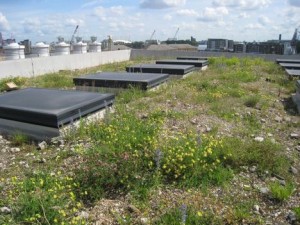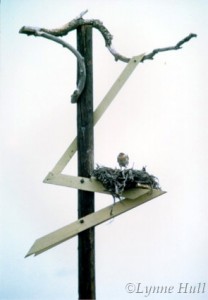This week was a very exciting week in Portland, Oregon because the city brought in ecoroof expert, Dusty Gedge. Along with Stephan Brenneisen they are two of the leading experts in creating ecoroofs that are aimed at biodiversity instead of only stormwater management. Both have written many good articles and designed many roofs in the U.K. and Switzerland.
The city of Portland just finished off Ecoroof Portland month, which included an event two weeks ago with vendors and many speakers. This week included two talks with Dusty and an ecoroof design charrette that I was lucky enough to be invited to and participate in, also with Dusty. The city of Portland is really moving forward the biodiversity effort and now including incentives for building owners to install ecoroofs on their buildings.
Dusty Gedge is the co-founder of Livingroofs.org and has been instrumental in creating habitat for the endangered Black Redstart in London. Blackredstarts.org.uk is an excellent resource for learning about this bird’s history, ecology, distribution, and mitigation. There are also some good diagrams and images of ecoroofs that have been installed for this bird. In addition to design, research, education and a multitude of other objectives, Dusty has also been involved in the London Biodiversity Partnership which “brings together organisations to benefit wildlife and boost the capital’s greenspaces.” Definitely visit that website, it has some excellent information and the London Biodiversity Action Plan has some greatly detailed goals about habitat types, target species and specific target goals of hectares of area to improve on by 2015.
Some of the topics Dusty talks about are new ideas about creating habitat for spiders and using them also as an indicator. If spiders are found in the variety of habitat areas on a roof, from the tall vegetation to the bare ground, it’s a sign that it’s a successful ecosystem.
Among some of the design strategies to creating a good biodiversity roof are good topography with varying substrate depths, shelter from wind and sun. Using varying substrate materials also increases biodiversity by offering a variety of materials for the various plants to grow in. Studying the two major environmental factors, wind and sun and using their prevailing directions to design mounds will create micro-habitats among the varying topography that will create shelter for insects, birds and plants. Each mound, depending on it’s shape will have different growth on each side and slope depending on the direction of wind and sun.
Connectivity was also a topic of discussion because it’s so important for much habitat, but when thinking about aerial colonizers such as bees and many birds, it’s less important and islands in the middle of the city have the potential for habitat despite being unconnected to other habitat.
As for plants, Dusty suggests, especially for bees, using a good mix of flowers and forbs to ensure constant blooming time throughout bees active months.
Many of these biodiverse ecoroofs are functional, they have ecologic integrity, not necessarily aesthetic integrity as Dusty stated. I believe that they can have both however. There are elements of the roofs that are going to be unattractive in the traditional sense during times of the year, when plants get brown for example. However, the overall design can be both functional and aesthetic, especially as people start to recognize the benefits and see the butterflies and birds flitting around the roofs. Natural elements are becoming more attractive in recent time. Walk into a hip furniture store and just see how many natural elements are creeping into furniture such as unfinished wood and rocks. There are also many environmental artists who have successfully incorporated natural elements into art such as nesting posts for hawks by artist Lynne Hull. Ecology can be functional and attractive and hopefully that will be the next step.
Many good ideas came out of the design charrette as well and I’ll post more about it here once the information from the charrette has been compiled and distributed to the attendees. Among some of the ideas were using specific substrate materials to allow ground nesting bees to dig in and the potential of hot air exhaust vents on the roof to create micro-habitats and even an area for maternity houses for bats.
There’s a good local news story and video about Dusty’s visit as well as the ecoroof tour including interviews with Bob Sallinger of Portland Audubon, Dusty Gedge and Tom Lipton from the City of Portland. Visit it here: Portland taking eco-roofs to a new level: KGW News
Visit Dusty Gedge’s home page.
Follow Dusty on his blog: Roofs & Rambles
Read an article by Dusty: From Rubble to Redstarts
And another article by Dusty: Wild Roofs: Current research into green roofs and biodiversity in London
There’s a good article about Dusty from Horticulturist Magazine, read it here: Roofing for Nature
Dusty in the Ecologist: Case Study: installing green roofs
The Urban Habitats e-journal had an excellent volume dedicated to Green Roofs and Biodiversity with many good articles and should absolutely be read.
Jim Labbe from Portland Audubon has a good blog post about touring London’s ecoroofs with Dusty on his blog.
Treehugger article about ecoroofs and Dusty: Roof Gardens will Save the Bugs
Check out Jason King’s blog for his take on Dusty’s visit to Portland: Landscape+Urbanism: Rooftop Habitats
This is one of my favorite subjects and I studied Dusty’s work in great detail while at school and my comprehensive project was directly influenced by his work. It was a great pleasure to get to participate in the charrette with him and listen to him speak as well. There will absolutely be many more posts about this topic here in the future.
………………………………………………………………….
[Update 4/8/10]Oregon Public Broadcasting has a nice article about ecoroofs and talks to Dusty when he was in Portland. Roof Colors Become Hot, or Cool, Topic








One Comment